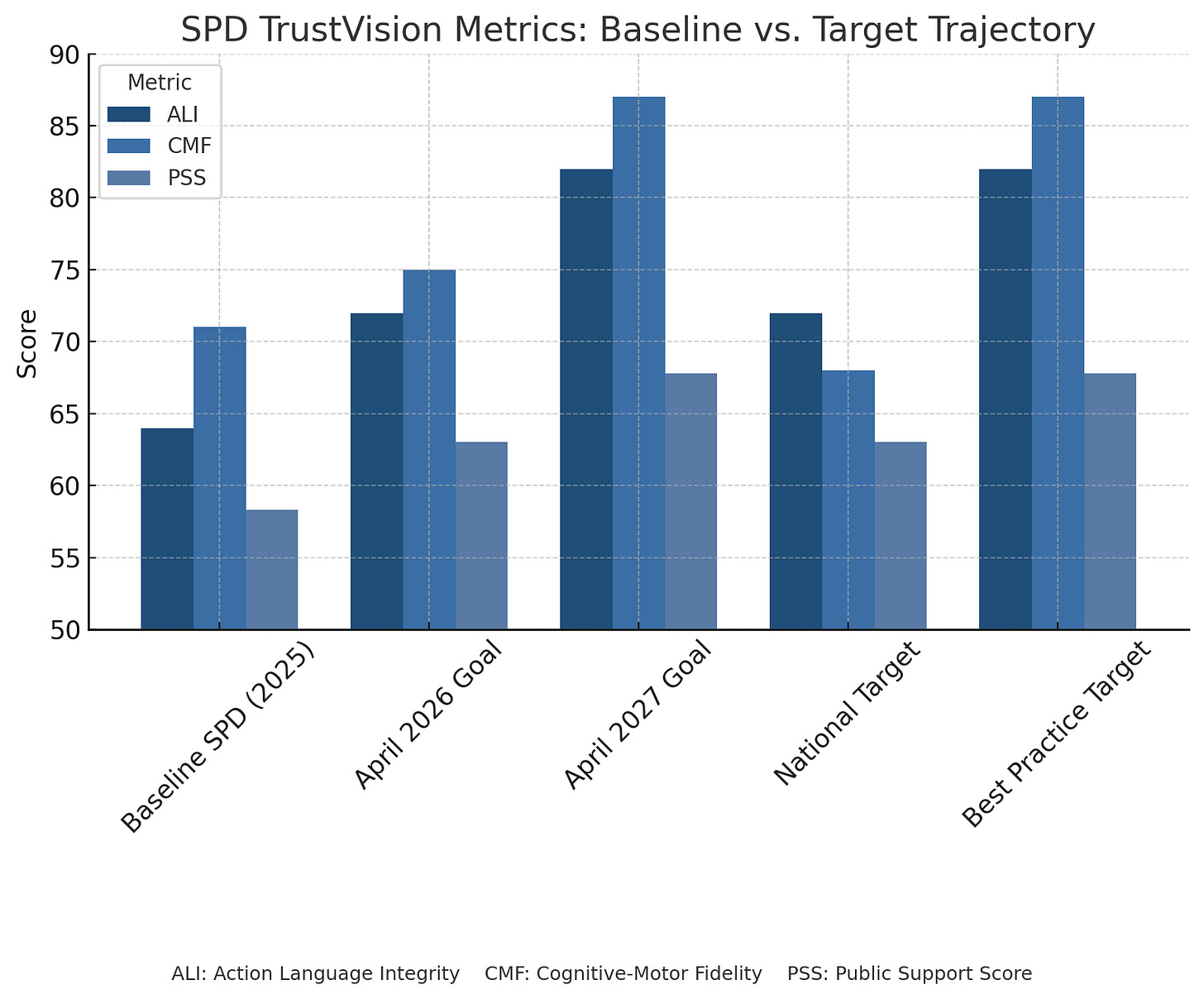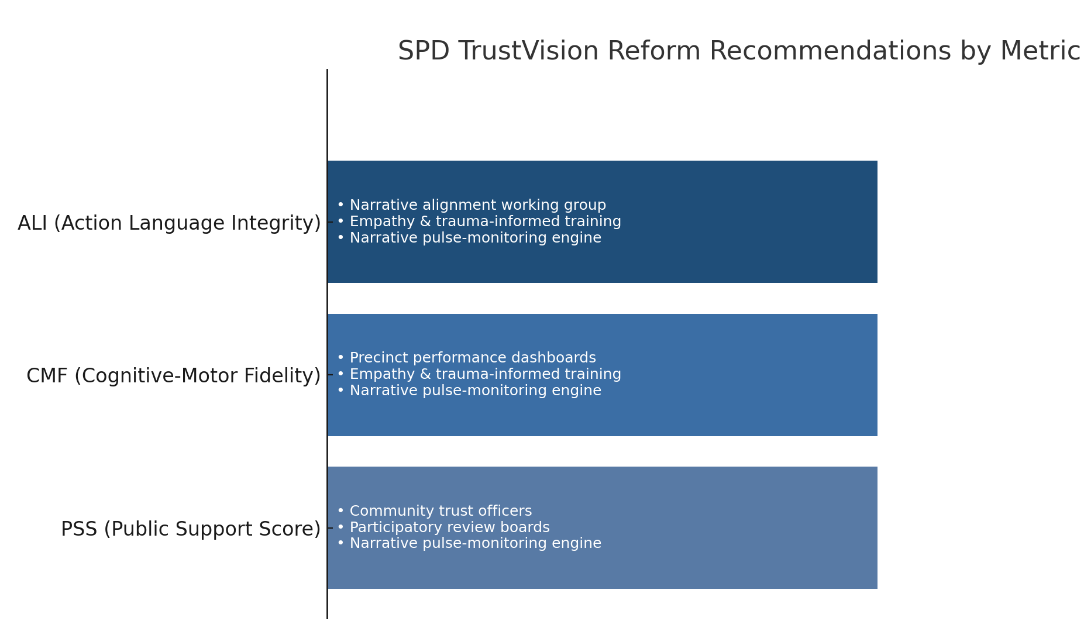MCAI Public Trust Vision: Seattle Police Department Case Study.
Prepared by Noel Le, Founder| Architect MindCast AI LLC 4/6/2025. Subscribe for updates. MindCast.AI@icloud.com
Executive Summary- Restoring Public Trust in Law Enforcement through Simulation and Strategic Clarity
MindCast AI (MCAI) models how people and institutions judge and make decisions—and how they’re perceived when it matters most. At its core, MCAI combines law and economics, behavioral economics, AI simulation, and systems forecasting to scale decision-making under uncertainty.
To adapt MCAI’s patent pending solutions to law enforcement, MCAI created the Public TrustVision framework (TrustVision-LE), customized from the standard MCAI Cognitive Digital Twin (CDTs) framework.
TrustVision-LE CDTs simulate the internal decision-making structure of an agency (leadership intent, operational flow, officer behavior) alongside the external perception of the public (emotional trust, narrative interpretation, and reaction to reform). MCAI also created a TrustVision-Public CDT for the general public
TrustVision-LE recognizes the chaotic nature of law enforcement, when executive function must perform in real-time for situations agencies must bring under control.
MCAI Law Enforcement Simulation
TrustVision-LE doesn’t just diagnose where breakdowns occur—it simulates how institutional alignment and public trust can be restored under stress, before the pressure hits. CDTs allow us to track—and simulate—three dimensions of institutional trust:
• ALI (Action Language Integrity) is weakened by inconsistent follow-through on reform messaging, deepening public skepticism.
• CMF (Cognitive-Motor Fidelity) reflects gaps between SPD’s strategic goals and actual officer behavior in the field.
• PSS (Public Support Score) remains low—not due to performance failure, but due to emotional disconnection and narrative volatility.
CDTs, and specifically the TrustVision-LE CDT, aren’t backward-looking diagnostics. The AI in TrustVision-LE forecasts trust trajectories, simulates public reactions based on TrustVision-Public, to proposed decisions, and detects internal misalignment before it manifests as public breakdown.
MCAI ran the TrustVision-LE through MCAI’s forecasting engine to the Seattle Police Department (SPD) using public data, sentiment signals, and simulation modeling.
Seattle Police Department Findings
The MCAI findings are that SPD’s values, behaviors, and perceived identity are out of sync. Simulating the issues enables coherent, proactive improvement strategies.
As part of the simulation, MCAI tested what would happen if Seattle’s crime rates continued trending downward. The results were positive: sustained reductions alone would lift SPD’s scores across all three metrics.
However, MCAI’s recommendation is not to rely on trends alone. Instead, we designed a proactive improvement plan tailored to strengthen SPD’s strategic clarity and emotional alignment with the communities it serves.
Recommendations
The MCAI simulation roadmap includes the following recommendations. We created CDTs for leading police departments who boast differentiators that can address the root causes of SPD’s current metrics.
• Synchronizing department-wide messaging and public engagement
• Embedding trust officers at the community level
• Publishing transparent precinct performance dashboards
• Training all officers in trauma-informed and emotionally intelligent policing
• Using AI to forecast public trust shifts and preempt reputational risk
• Establishing participatory review boards to rebuild democratic legitimacy
Recreating the Seattle Police Department as a First Tier Agency
The strategy is aimed at restoring SPD to national trust benchmarks by 2026—and positioning it among the most trusted municipal agencies by 2027.
Each initiative is modeled to improve one or more institutional trust dimensions.
The roadmap isn’t theoretical. It’s already simulated and calibrated to improve outcomes, even if conditions remain turbulent—and especially if leaders act before the next crisis.
MCA factored in public cognitive dissonance dynamics of expressing dissatisfaction with law enforcement, while relying on the service and dedication. We adjusted for the disconnect between expressions of public trust, and the inherent trust conveyed in public reliance by simulating the interaction of SPD with the CDT for the public.
*****
Please find copies of the baseline report and the SPD report below. If you believe in restoring public trust through behavioral realism and foresight, feel free to share or restack.
1. TrustVision Law Enforcement Baseline Report (April 2025)
https://myaidrive.com/file/FaLhtkxZezdfwikUWKhf4C
2. SPD Strategic Reform Report (April 2025)




